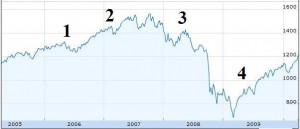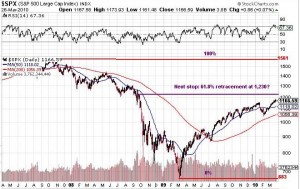Before we discuss “Sell in May and go away”, I posted an update yesterday on my covered call option writing strategy. I posted it as a separate entry, so that those of you who don’t care can ignore it. The quick summary was that the strategy was successful, and will probably be repeated next month. All comments welcome. Now, to the business at hand:
There are lots of theories on the subject, but should we sell in May and go away? The definitive answer is:
Maybe.
Here’s a chart of the S&P 500 for the last five years (click on it for a larger version). I have noted the peaks around the May period, and here is whether or not “Sell in May and Go Away” worked.
1 May 5, 2006, peak at 1,326, so selling in May worked
2 Feb 23, 2007 peak at 1,451, then a drop, then a recovery in to July, before the next drop, so selling in May was a bad idea
3 May 16, 2008, peak at 1,425, the high for the year, so selling in May worked perfectly
4 May 8, 2009, peak at 929, then consolidation down to 879 on July 10, and then upwards from then until now, so selling in May was a bad idea
You can look back to other years for more data. Selling in May in 2005 was a bad idea; selling in May 2004 worked. So, what do I conclude from this statistical summary? Sell in May and go away works in some years, and not others.
Brilliant.
Of course, you could argue there is a pattern here:
- 2004 – sell
- 2005 – don’t sell
- 2006 – sell
- 2007 – don’t sell
- 2008 – sell
- 2009 – don’t sell
- 2010 – sell ???
On this basis, we should be selling this May. Or not.
I realize that each of you reads this blog each week for insightful analysis, and given what you are paying for my analysis, you all deserve something more than just a cursory review of a chart, and a simplistic assertion that this is an off year, and therefore we should sell in May and go away. So I now present my new Basic Unified Long Logarithmic Simplified Holistic Integrated Theory of the markets. (Too bad I couldn’t come up with initials that meant something). Here’s how it works:
Start with the first year in the modern market era, 1991. 1991, as you know, is a palindrome (which has nothing to do with Sarah Palin), but more importantly it was the year that was the start of Operation Desert Storm, with air strikes against Iraq. Here we are, two decades later, still in Iraq. 1991 also marked the collapse of the Soviet Union, with Georgia, Belarus, Estonia, Latvia, Moldova, Azerbaijan, Kyrgyzstan and Uzbekistan declaring their independence. Clearly those events are still reverberating to this day.
To analyze this string, we start with 1991, and then apply a mathematical formula, as described in Wikipedia. Here are the results:
- 1991 – eeny
- 1992 – meeny
- 1993 – miny
- 1994 – moe
- 1995 – catch
- 1996 – a
- 1997 – tiger
- 1998 – by
- 1999 – the
- 2000 – toe
- 2001 – if
- 2002 – he
- 2003 – hollers
- 2004 – let
- 2005 – him
- 2006 – go
- 2007 – eeny
- 2008 – meeny
- 2009 – miny
- 2010 – moe
Bingo. 2010 is “moe”, so that also means we should Sell in May and Go Away.
Freaky, eh?
Here’s one more: I have written a few times over the last few weeks on Fibonacci retracement levels. The concept is relatively simple: patterns tend to repeat themselves. A trend, whether it be a market, or a stock, will go from 0 to 100, and then pull back to common Fibonacci levels.
Here’s the chart I showed back on March 27:
The S&P 500 peaked at around 1,561, and then dropped to around 683. A bounce back by 61.8%, which is a key Fibonacci level, would bring the market back to somewhere in the range of 1,225 to 1,230, depending on the exact data points you use.
On Thursday of this week the S&P 500 peaked at around 1,214, and then fell all the way to around 1,187 on Friday morning, before recovering to close the week at 1,192. In other words the market got close to the key level, but didn’t quite make it there.
What does this mean?
Perhaps nothing. Or perhaps it means that the 1,225 level is in fact a key resistance level, and we may be close to, or already at, a top. That would indicate that sell in May and go away may very well work this year.
Of course there are other factors at play as well. The significant disruption of travel in Europe due to the volcano in Iceland won’t help the economy, and the disruptions and food shortages could last for months. That’s certainly not a development that will help the market rally.
Even more significant are the fraud charges brought by the SEC against Goldman Sachs. This could be the most significant story of the decade. We know that the big Boys manipulate the market. We know that the markets have risen over the last few months despite relatively low volume and participation, due largely, perhaps, to the involvement of the market manipulators. To this point the SEC has done nothing. Now, for the first time, they are actually doing something. What’s next? Will they start investigating JP Morgan for manipulating the gold and silver market?
I said it could be the most significant story of the decade, but only if it’s real. It probably isn’t. The public has started to advocate for some regulation, so this SEC action is probably just a way to appease the public, to make it appear that they are actually doing something. The penalty will be a slap on the wrist, and will ultimately mean nothing.
However, there are enough storm clouds on the horizon (not to mention volcanic ash) that convinces me that this year, sell in May and go away will be the correct strategy. I will bear that in mind as I keep my cash levels high, and perhaps pick up some puts as downside protection over the coming weeks. If you don’t believe me, do your own detailed mathematical analysis.
Eeny meeny miny moe.
You’re it. See you next week.


{ 0 comments… add one now }
You must log in to post a comment.
{ 2 trackbacks }